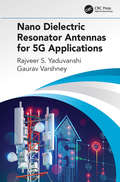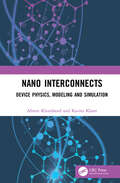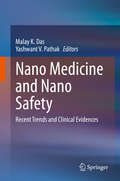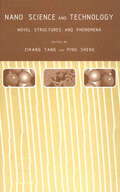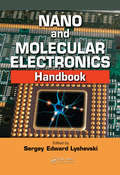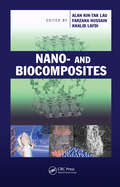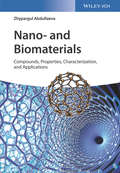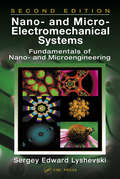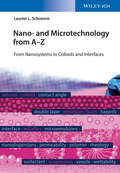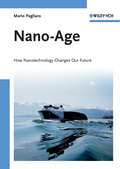- Table View
- List View
Nano Dielectric Resonator Antennas for 5G Applications
by Rajveer S. Yaduvanshi Gaurav VarshneyWe are always surrounded by electromagnetic waves and fields of various spectra. This book explains basic electromagnetic theory with the help of design formulations i.e. mathematical background on antennas along with experimentations, which has made this book unique. The main purpose of this book is to embed mathematical EM theory of dielectric resonator antennas with experimental validation so that understanding of concepts takes place. Initially, basic understanding of philosophy of dielectric resonators has been discussed, then it is supported with mathematical modeling and later same is implemented with its prototype model along with experimentations. The modes theory gives important analysis on currents distribution, impedance analysis and radiation pattern in DRA. Circular polarization can built signal robustness, case studies on circular polarization has been included. Equivalent RLC circuit concept has been introduced. Challenges of switching from microwave to terahertz has been briefly discussed. Nano DRA will revolutionize the wireless technology. Nano DRA ,Terahertz DRA and Quantum DRA have analyzed and studied.
Nano Drug Delivery for Cancer Therapy: Principles and Practices
by Firdos Alam KhanThis book discusses the various modes and methods of nano-based drug delivery in different types of cancers such as colon, breast, cervical, ovarian, and lung cancer. It reviews the significance of nano drug delivery in cancer therapy, the application of nanoparticles in overcoming drug resistance, targeted therapy, and immunotherapy. The book also covers topics related to the synthesis of different types, shapes, and sizes of nanocarriers using synthetic and biological approaches. Further, a chapter explores the synthesis of nanocarriers loaded with anti-cancer drugs by using functionalization or conjugations and encapsulation methods. The book also examines the nanocarriers as delivery vehicles for chemotherapeutic agents against cancers using in vitro and animal models of cancers, preclinical trials for efficacy, and safety profiling of nanocarriers. Finally, future trends and innovation in nano drug delivery for cancer therapy, application of siRNA (nanoparticle-based RNA) therapy, ultrasound-linked nano-cancer therapeutics, and application of exosome-based cancer therapy topics are discussed. Towards the end, the book examines the limitations of nanocarriers, including the cell and tissue toxicity, genotoxicity, and scale-up of nanomaterials, health and environmental hazards associated with nanoformulation synthesis, respiratory diseases, government regulations, and ethical issues.
Nano Emulsions in Enhanced Oil Recovery (SpringerBriefs in Petroleum Geoscience & Engineering)
by Amit Kumar Neha Saxena Ajay MandalThis book focuses on the use of nanoemulsion in enhanced oil recovery, along with a brief information about the emulsion and its types and different physico-chemical properties used to analyse the efficiency of the emulsions and nanoemulsions. The author discussed about the nanoemulsion, classification of emulsions and nanoemulsion and use of nanoemulsions in petroleum industry. A special attention has been laid on nanoemulsion and its advantages over commercial product, physico-chemical properties like emulsification, interfacial tension and wettability alteration study as a screening criteria for application in EOR. Given this content, this book offers an assessment for the undergraduate and postgraduate students of petroleum and chemical engineering along with the researchers working in the field of EOR. It is a subject of interest for oil and gas industry professionals.
Nano Enhanced Phase Change Materials: Preparation, Properties and Applications (Materials Horizons: From Nature to Nanomaterials)
by Adarsh Kumar Pandey Zafar SaidThis book provides information on thermal energy storage systems incorporating phase change materials (PCMs) which are widely preferred owing to their immense energy storage capacity. The thermal energy storage (TES) potential of PCMs has been deeply explored for a wide range of applications, including solar/electrothermal energy storage, waste heat storage, and utilization, building energy-saving, and thermal regulations. The inherent shortcomings like leakage during phase transition and poor thermal conductivity hamper their extensive usage. Nevertheless, it has been addressed by their shape stabilization with porous materials and dispersing highly conductive nanoparticles. Nanoparticles suspended in traditional phase change materials enhance the thermal conductivity. The addition of these nanoparticles to the conventional PCM enhances the storage. In this book, the history of Nano Enhanced Phase Change Materials (NEPCM), preparation techniques, properties, theoretical modeling and correlations, and the effect of all these factors on the potential applications such as: solar energy, electronics cooling, heat exchangers, building, battery thermal management, thermal energy storage are discussed in detail. Future challenges and future work scope have been included. The information from this book can enable the readers to come up with novel techniques, resolve existing research limitations, and come up with novel NEPCM, that can be implemented for various applications.
Nano Hydrogels: Physico-Chemical Properties and Recent Advances in Structural Designing (Gels Horizons: From Science to Smart Materials)
by Sabu Thomas Vijay Kumar Thakur Jiya JoseThis book introduces the reader to important aspects of the nano-hydrogels. It covers the development of hydrogels and their biology, chemistry and properties. Focus is also given to innovative characterization techniques and advances in structural design, with special emphasis on molecular structure, dynamic behavior and structural modifications of hydrogels. This book serves as a consolidated reference work for the diverse aspects of hydrogels, creating a valuable resource for students and researchers in academia and industry.
Nano Interconnects: Device Physics, Modeling and Simulation
by Afreen Khursheed Kavita KhareThis textbook comprehensively covers on-chip interconnect dimension and application of carbon nanomaterials for modeling VLSI interconnect and buffer circuits. It provides analysis of ultra-low power high speed nano-interconnects based on different facets such as material modeling, circuit modeling and the adoption of repeater insertion strategies and measurement techniques. It covers important topics including on-chip interconnects, interconnect modeling, electrical impedance modeling of on-chip interconnects, modeling of repeater buffer and variability analysis. Pedagogical features including solved problems and unsolved exercises are interspersed throughout the text for better understanding. Aimed at senior undergraduate and graduate students in the field of electrical engineering, electronics and communications engineering for courses on Advanced VLSI Interconnects/Advanced VLSI Design/VLSI Interconnects/VLSI Design Automation and Techniques, this book: Provides comprehensive coverage of fundamental concepts related to nanotube transistors and interconnects. Discusses properties and performance of practical nanotube devices and related applications. Covers physical and electrical phenomena of carbon nanotubes, as well as applications enabled by this nanotechnology. Discusses the structure, properties, and characteristics of graphene-based on-chip interconnect. Examines interconnect power and interconnect delay issues arising due to downscaling of device size.
Nano Lithography (Wiley-iste Ser.)
by Stefan LandisLithography is an extremely complex tool – based on the concept of “imprinting” an original template version onto mass output – originally using relatively simple optical exposure, masking, and etching techniques, and now extended to include exposure to X-rays, high energy UV light, and electron beams – in processes developed to manufacture everyday products including those in the realms of consumer electronics, telecommunications, entertainment, and transportation, to name but a few. In the last few years, researchers and engineers have pushed the envelope of fields including optics, physics, chemistry, mechanics and fluidics, and are now developing the nanoworld with new tools and technologies. Beyond the scientific challenges that are endemic in this miniaturization race, next generation lithography techniques are essential for creating new devices, new functionalities and exploring new application fields. Nanolithography is the branch of nanotechnology concerned with the study and application of fabricating nanometer-scale structures − meaning the creation of patterns with at least one lateral dimension between the size of an individual atom and approximately 100 nm. It is used in the fabrication of leading-edge semiconductor integrated circuits (nanocircuitry) or nanoelectromechanical systems (NEMS).This book addresses physical principles as well as the scientific and technical challenges of nanolithography, covering X-ray and NanoImprint lithography, as well as techniques using scanning probe microscopy and the optical properties of metal nanostructures, patterning with block copolymers, and metrology for lithography. It is written for engineers or researchers new to the field, and will help readers to expand their knowledge of technologies that are constantly evolving.
Nano Medicine and Nano Safety: Recent Trends and Clinical Evidences
by Malay K. Das Yashwant V. PathakThis book reviews the application of Nanobiotechnology in the development of Nanomedicine, while also discussing the latest trends and challenges in the clinical translation of Nanomedicine. Nanomedicine refers to the application of Nanotechnology to medicine and holds tremendous potential for achieving improved efficiency, bioavailability, dose response, personalized medicine and enhanced safety as compared to conventional medicines.The book first introduces readers to the basic concepts of Nanomedicine, and to technological advances in and applications of Nanotechnology in treatment, diagnosis, monitoring, and drug delivery. In turn, it reviews the current status of multi-functionalization strategies for using Nanoparticles in the targeted delivery of therapeutic agents. The book’s third and final section focuses on the regulatory and safety challenges posed by Nanomedicine, including industry and regulatory agencies’ efforts to address them.
Nano Metal Oxides: Engineering and Biomedical Applications
by B. Karthikeyan G. Gnanakumar A. Therasa AlphonsaThis book highlights theoretical and experimental facts about selective nano-metal oxides. TiO2 ,ZnO and transition metal oxides which are known to be semiconductors and find applications in various fields. This book presents about recent findings like photo catalysis, sensing ,coating and biomedical applications. Therapeutic and future applications that are recently been reported of various metal oxides are presented in this book.
Nano Science and Technology: Novel Structures and Phenomena
by Zikang Tang Ping ShengNanoscience and technology is a rapidly developing area of research in physics, chemistry, and materials. This volume comsists of papers presented at the Advanced Study Institute in Hong Kong that explore developments in novel structures in phenomena of nanostructured materials. The topics include:two-dimensional nanoclusters on met
Nano and Biotech Based Materials for Energy Building Efficiency
by Volodymyr Ivanov F. Pacheco Torgal Cinzia Buratti Siva Kalaiselvam Claes-Göran GranqvistThis book presents the current state of knowledge on nanomaterials and their use in buildings, ranging from glazing and vacuum insulation to PCM composites. It also discusses recent applications in organic photovoltaics, photo-bioreactors, bioplastics and foams, making it an exciting read while also providing copious references to current research and applications for those wanting to pursue possible future research directions. Derek Clements-Croome, Emeritus Professor in Architectural Engineering, University of Reading (From the Foreword) Demonstrating how higher energy efficiency in new and existing buildings can help reduce global greenhouse gas emissions, this book details the way in which new technologies, manufacturing processes and products can serve to abate emissions from the energy sector and offer a cost-effective means of improving competitiveness and drive employment. Maximizing reader insights into how nano and biotech materials - such as aerogel based plasters, thermochromic glazings and thermal energy adsorbing glass, amongst others - can provide high energy efficiency performance in buildings, it provides practitioners in the field with an important high-tech tool to tackle key challenges and is essential reading for civil engineers, architects, materials scientists and researchers in the area of the sustainability of the built environment.
Nano and Cell Mechanics: Fundamentals and Frontiers (Microsystem and Nanotechnology Series (ME20) #11)
by Gang Bao Horacio D. EspinosaResearch in nano and cell mechanics has received much attention from the scientific community as a result of society needs and government initiatives to accelerate developments in materials, manufacturing, electronics, medicine and healthcare, energy, and the environment. Engineers and scientists are currently engaging in increasingly complex scientific problems that require interdisciplinary approaches. In this regard, studies in this field draw from fundamentals in atomistic scale phenomena, biology, statistical and continuum mechanics, and multiscale modeling and experimentation. As a result, contributions in these areas are spread over a large number of specialized journals, which prompted the Editors to assemble this book. Nano and Cell Mechanics: Fundamentals and Frontiers brings together many of the new developments in the field for the first time, and covers fundamentals and frontiers in mechanics to accelerate developments in nano- and bio-technologies. Key features: • Provides an overview of recent advances in nano and cell mechanics. • Covers experimental, analytical, and computational tools used to investigate biological and nanoscale phenomena. • Covers fundamentals and frontiers in mechanics to accelerate developments in nano- and bio-technologies. • Presents multiscale-multiphysics modeling and experimentation techniques. • Examines applications in materials, manufacturing, electronics, medicine and healthcare. Nano and Cell Mechanics: Fundamentals and Frontiers is written by internationally recognized experts in theoretical and applied mechanics, applied physics, chemistry, and biology. It is an invaluable reference for graduate students of nano- and bio-technologies, researchers in academia and industry who are working in nano and cell mechanics, and practitioners who are interested in learning about the latest analysis tools. The book can also serve as a text for graduate courses in theoretical and applied mechanics, mechanical engineering, materials science, and applied physics.
Nano and Micromachining (Wiley-iste Ser.)
by J. Paulo Davim Mark J. JacksonThis book provides the fundamentals and recent advances in nano and micromachining for modern manufacturing engineering. It begins by outlining nanomachining before discussing various advances in field and machining processes. The coverage concludes with an evaluation of subsurface damages in nano and micromachining and a presentation of applications in industry. As such, this book serves both as a useful classroom text for engineering and machining courses at the undergraduate and graduate level, and as a reference for academics and engineers in these areas.
Nano and Molecular Electronics Handbook (Nano and Microengineering Series)
by Sergey Edward LyshevskiThere are fundamental and technological limits of conventional microfabrication and microelectronics. Scaling down conventional devices and attempts to develop novel topologies and architectures will soon be ineffective or unachievable at the device and system levels to ensure desired performance. Forward-looking experts continue to search for new paradigms to carry the field beyond the age of microelectronics, and molecular electronics is one of the most promising candidates. The Nano and Molecular Electronics Handbook surveys the current state of this exciting, emerging field and looks toward future developments and opportunities.Molecular and Nano Electronics ExplainedExplore the fundamentals of device physics, synthesis, and design of molecular processing platforms and molecular integrated circuits within three-dimensional topologies, organizations, and architectures as well as bottom-up fabrication utilizing quantum effects and unique phenomena.Technology in ProgressStay current with the latest results and practical solutions realized for nanoscale and molecular electronics as well as biomolecular electronics and memories. Learn design concepts, device-level modeling, simulation methods, and fabrication technologies used for today's applications and beyond.Reports from the Front Lines of ResearchExpert innovators discuss the results of cutting-edge research and provide informed and insightful commentary on where this new paradigm will lead. The Nano and Molecular Electronics Handbook ranks among the most complete and authoritative guides to the past, present, and future of this revolutionary area of theory and technology.
Nano and Quantum Optics: An Introduction to Basic Principles and Theory (Graduate Texts in Physics)
by Ulrich HohenesterThis classroom-tested textbook is a modern primer on the rapidly developing field of quantum nano optics which investigates the optical properties of nanosized materials. The essentials of both classical and quantum optics are presented before embarking through a stimulating selection of further topics, such as various plasmonic phenomena, thermal effects, open quantum systems, and photon noise. Didactic and thorough in style, and requiring only basic knowledge of classical electrodynamics, the text provides all further physics background and additional mathematical and computational tools in a self-contained way. Numerous end-of-chapter exercises allow students to apply and test their understanding of the chapter topics and to refine their problem-solving techniques.
Nano- and Biocatalysts for Biodiesel Production
by Avinash P. IngleReviews recent advances in catalytic biodiesel synthesis, highlighting various nanocatalysts and nano(bio)catalysts developed for effective biodiesel production Nano- and Biocatalysts for Biodiesel Production delivers an essential reference for academic and industrial researchers in biomass valorization and biofuel industries. The book covers both nanocatalysts and biocatalysts, bridging the gap between homogenous and heterogenous catalysis. Readers will learn about the techno-economical and environmental aspects of biodiesel production using different feedstocks and catalysts. They will also discover how nano(bio)catalysts can be used as effective alternatives to conventional catalysts in biodiesel production due to their unique properties, including reusability, high activation energy and rate of reaction, easy recovery, and recyclability. Readers will benefit from the inclusion of: Introductions to CaO nanocatalysts, zeolite nanocatalysts, titanium dioxide-based nanocatalysts and zinc-based in biodiesel production An exploration of carbon-based heterogeneous nanocatalysts for the production of biodiesel Practical discussions of bio-based nano catalysts for biodiesel production and the application of nanoporous materials as heterogeneous catalysts for biodiesel production An analysis of the techno-economical considerations of biodiesel production using different feedstocks Nano- and Biocatalysts for Biodiesel Production focuses on recent advances in the field and offers a complete and informative guide for academic researchers and industrial scientists working in the fields of biofuels and bioenergy, catalysis, biotechnology, bioengineering, nanotechnology, and materials science.
Nano- and Biocomposites
by Alan Kin-Tak Lau Farzana Hussain Khalid LafdiAdvances in nanotechnology are leading to the creation of composites with a myriad of medical applications. This forward-thinking book melds research in biocomposites with advances in nanocomposite technology to provide an interdisciplinary resource on advanced materials for the biomedical industry. It brings together pioneering researchers who describe their contributions to the field. Among other areas, they cover nanostructured polymer composites and nano/bio composites. They look at developments in tissue engineering, safer resins for tooth and bone repair, and improved artificial joints. They also discuss potential opportunities for continued research in this well-funded field.
Nano- and Biomaterials: Compounds, Properties, Characterization, and Applications
by Zhypargul AbdullaevaA comprehensive introduction to nano- and biomaterials shining light on the different research disciplines from various perspectives. The straightforward and well-structured concept is designed to cater for entrants as well as experienced researchers in the field of nanotechnology. The initial chapters introduce nanomaterials, their classification and synthesis techniques, while subsequent chapters discuss the various characterization tools as well as mechanical properties and their applications in biotechnological and biomedical fields. Further understanding of the topic is supported by case studies used for practical purposes. The book concludes with a look at future technology advances. With its explanation of a wide variety of materials, this is an essential reference for chemists, physicists, materials scientists and biomedical engineers.
Nano- and Micro-Electromechanical Systems: Fundamentals of Nano- and Microengineering, Second Edition
by Sergey Edward LyshevskiSociety is approaching and advancing nano- and microtechnology from various angles of science and engineering. The need for further fundamental, applied, and experimental research is matched by the demand for quality references that capture the multidisciplinary and multifaceted nature of the science. Presenting cutting-edge information that is applicable to many fields, Nano- and Micro-Electromechanical Systems: Fundamentals of Nano and Microengineering, Second Edition builds the theoretical foundation for understanding, modeling, controlling, simulating, and designing nano- and microsystems. The book focuses on the fundamentals of nano- and microengineering and nano- and microtechnology. It emphasizes the multidisciplinary principles of NEMS and MEMS and practical applications of the basic theory in engineering practice and technology development. Significantly revised to reflect both fundamental and technological aspects, this second edition introduces the concepts, methods, techniques, and technologies needed to solve a wide variety of problems related to high-performance nano- and microsystems. The book is written in a textbook style and now includes homework problems, examples, and reference lists in every chapter, as well as a separate solutions manual. It is designed to satisfy the growing demands of undergraduate and graduate students, researchers, and professionals in the fields of nano- and microengineering, and to enable them to contribute to the nanotechnology revolution.
Nano- and Microencapsulation for Foods
by Hae-Soo KwakToday, nano- and microencapsulation are increasingly being utilized in the pharmaceutical, textile, agricultural and food industries. Microencapsulation is a process in which tiny particles or droplets of a food are surrounded by a coating to give small capsules. These capsules can be imagined as tiny uniform spheres, in which the particles at the core are protected from outside elements by the protective coating. For example, vitamins can be encapsulated to protect them from the deterioration they would undergo if they were exposed to oxygen. This book highlights the principles, applications, toxicity and regulation of nano- and microencapsulated foods. Section I describes the theories and concepts of nano- and microencapsulation for foods adapted from pharmaceutical areas, rationales and new strategies of encapsulation, and protection and controlled release of food ingredients. Section II looks closely at the nano- and microencapsulation of food ingredients, such as vitamins, minerals, phytochemical, lipid, probiotics and flavors. This section provides a variety of references for functional food ingredients with various technologies of nano particles and microencapsulation. This section will be helpful to food processors and will deal with food ingredients for making newly developed functional food products. Section III covers the application of encapsulated ingredients to various foods, such as milk and dairy products, beverages, bakery and confectionery products, and related food packaging materials. Section IV touches on other related issues in nano- and microencapsulation, such as bioavailability, bioactivity, potential toxicity and regulation.
Nano- and Microtechnology from A - Z
by Laurier L. SchrammThis reference provides brief explanations for the most important terms that may be encountered in a study of the fundamental principles, experimental investigations, and industrial applications of nano- and microscience, including colloid and interface science. More than a dictionary, the book also provides information on properties, units, equations, techniques, and pioneers in the field. The comprehensive content covers both current and older terms, complete cross-references for the most important synonyms, abbreviations, and acronyms, and numerous tables for the quick overview. An authoritative reference, vital for unhindered communication and knowledge transfer in this fast-growing and broadly interdisciplinary field.
Nano-Age: How Nanotechnology Changes Our Future
by Mario PagliaroIs the nano-age here to stay or will a bubble soon burst? This thought-provoking page-turner takes a critical glance at how nanotechnology has affected virtually all areas of our lives. From the pharmaceutical industry to energy production and storage, many fields have been truly revolutionized during the nano-age. The internationally renowned author explores the topic in nine entertaining chapters.
Nano-Antimicrobials
by Mahendra Rai Nicola CioffiThere is a high demand for antimicrobials for the treatment of new and emerging microbial diseases. In particular, microbes developing multidrug resistance have created a pressing need to search for a new generation of antimicrobial agents, which are effective, safe and can be used for the cure of multidrug-resistant microbial infections. Nano-antimicrobials offer effective solutions for these challenges; the details of these new technologies are presented here. The book includes chapters by an international team of experts. Chemical, physical, electrochemical, photochemical and mechanical methods of synthesis are covered. Moreover, biological synthesis using microbes, an option that is both eco-friendly and economically viable, is presented. The antimicrobial potential of different nanoparticles is also covered, bioactivity mechanisms are elaborated on, and several applications are reviewed in separate sections. Lastly, the toxicology of nano-antimicrobials is briefly assessed.
Nano-Bio Probe Design and Its Application for Biochemical Analysis
by Min Zhang Bin-Cheng Yin Bang-Ce YeIn this volume, Prof. Ye and his coworkers propose and review the concept of nano-bio probe design for biochemical analysis on the basis of their recent published works. A unique biochemical analysis technology based on fluorescence polarization enhanced by nanoparticles is described here with successful applications in environmental monitoring, rapid and sensitive sensing protease activity and high-throughput screening of inhibitors. Furthermore, they introduce a versatile molecular beacon (MB)-like probe for the multiplex sensing of targets such as sequence-specific DNA, protein, metal ions and small molecule compounds based on the self-assembled biomolecule-graphene conjugates. Besides, some colorimetric and luminescence probes utilizing metal nanoparticles for biochemical applications are also presented, such as chiral enantiomer discrimination and separation, environmental monitoring, clinic diagnosis and etc.
Nano-Bio- Electronic, Photonic and MEMS Packaging
by Yi Li Kyoung-Sik Jack Moon C. P. Ching-Ping WongThis book shows how nanofabrication techniques and nanomaterials can be used to customize packaging for nano devices with applications to electronics, photonics, biological and biomedical research and products. It covers topics such as bio sensing electronics, bio device packaging, MEMS for bio devices and much more, including:Offers a comprehensive overview of nano and bio packaging and their materials based on their chemical and physical sciences and mechanical, electrical and material engineering perspectives;Discusses nano materials as power energy sources, computational analyses of nano materials including molecular dynamic (MD) simulations and DFT calculations;Analyzes nanotubes, superhydrophobic self-clean Lotus surfaces;Covers nano chemistry for bio sensor/bio material device packaging.This second edition includes new chapters on soft materials-enabled packaging for stretchable and wearable electronics, state of the art miniaturization for active implantable medical devices, recent LED packaging and progress, nanomaterials for recent energy storage devices such as lithium ion batteries and supercapacitors and their packaging. Nano- Bio- Electronic, Photonic and MEMS Packaging is the ideal book for all biomedical engineers, industrial electronics packaging engineers, and those engaged in bio nanotechnology applications research.
